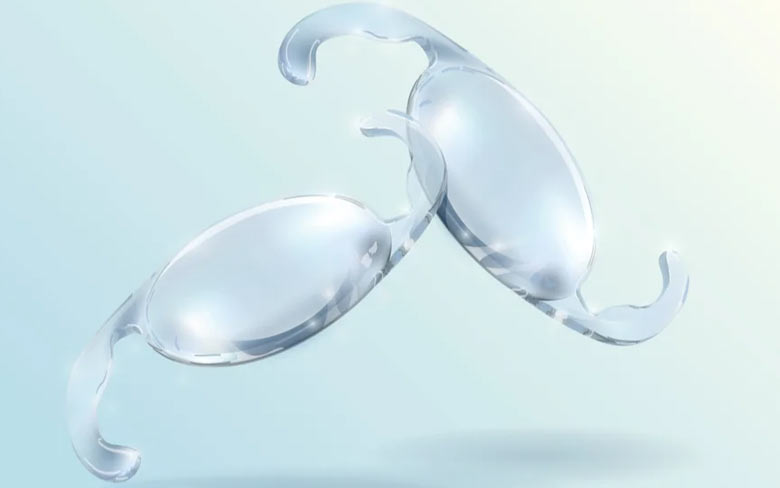Smart Lens
Eye Treatments
Smart Lens or Intraocular Lens
Smart Lens is an implant (artificial lens) made of a biocompatible material. It is installed in place of the natural lens in case of loss of the latter’s functions.
The artificial lens has two parts: an optical part and a supporting part. The optical part is clear and helps focus light properly for good vision. The supporting (haptic) part has two clamps and holds the Intraocular Lens (IOL) in place in your eye.

Table of Contents
Treatment Plan
1. Day
Meet your treating doctor
Detailed examination of your eyes and confirmation, if you are suitable for smart lens cataract surgery
Final decision on the lens, which will be the best for you
Your lenses will be prepared individually for you
Afterwards, you can relax and rest in the hotel or start your discovery tour
2. Day
Your new lenses are ready now, and the surgery can start!
Consultation with your treating doctor and preparation of the surgery
Smart lens cataract surgery takes in average 20 minutes per eye
You will not feel any pain as the entire procedure is performed under local anesthesia
To protect your eyes, you will be fitted with contact lenses.
You will be able to see immediately after the operation, but initially very blurred, as the eye needs time to adjust to the new lenses.
Information about what you should pay attention to in the next few days
Afterward you will leave the hospital, go to your hotel and relax
We strongly recommend that you diligently use the medications and eye drops that you receive from our clinic.
3. Day
Control by your treating doctor in our hospital
The contact lenses are removed.
Detailed examination of your eyes
4. Day
Concluding consultation and final examination of your eyes.
Smart Lens Types and Methods
Intraocular Lenses are used for:
- Treatment of cataracts of any severity (even combined with other pathologies);
- Refractive errors due to severe myopia, farsightedness or astigmatism.
Properties of modern intraocular lenses:
The first IOLs were hard and had to be cut to fit, making surgery tough with a slow recovery. What are the features of modern artificial lenses used in ophthalmology?
- Optical parameters. Every artificial lens (IOL) has unique features to improve vision. Doctors calculate the optical power indicators based on each patient’s needs and the surgery details.
- Excellent biocompatibility. Modern materials of artificial lenses do not cause allergies, excluding the possible rejection of the lens.
- Flexibility and elasticity. IOLs are very flexible. They’re folded and put into the eye through a tiny opening. Once inside, the lens unfolds itself in the right place.
- UV filter. The artificial lens can shield the retina from harmful UV rays using a special color filter. This doesn’t affect how colors look.
- Correction of spherical distortions. Aspherical lenses with a complex surface geometry improve the quality of vision at dusk and prevent glare.
- Astigmatism correction. For certain eye conditions like cataracts and astigmatism together, it’s better to use special toric lenses that fix both issues at once.
- Elimination of age-related farsightedness. As we get older (after 40-45 years), the lens in our eyes becomes less flexible, making it harder to focus on things up close or far away. This means we might need glasses for close-up tasks. But special new lenses called multifocal IOLs can help us see clearly at all distances, from close-up to far away.
Methods of implantation of intraocular lenses:
An intraocular lens (IOL) can go in the front or back part of the eye. These lenses come in different sizes, shapes, and materials. The important thing is to put the lens in a way that it doesn’t touch anything and doesn’t block the fluid inside the eye.
Features of implantation in the anterior chamber:
- This part of the eye has enough space to securely hold the lens, so the surgery is moderately complex.
- Optical calculation and measurements is quite simple.
- The lens material can be solid or flexible, elastic.
- The lens can be placed in the corner of the eye or on the iris.
- Possible complications include damaging the iris or lens, reduction in the number of endothelial cells, pupil shape changes, and chronic inflammation.
- Another feature of anterior chamber lenses is that others can see the lens because of glare.
Features of implantation in the posterior chamber:
- This method of implantation is technically more difficult, because there is much less free space in the posterior chamber of the eye.
- Optical calculation is complex and requires very precise special measurements.
- The lens material must be elastic, repeating the shape of the lens.
- Possible complications: violation of the free circulation of intraocular fluid and the risk of developing cataracts.
- Posterior chamber lenses cannot be seen from the side, they are visible only with a special examination.
As you can see, both methods have their advantages and disadvantages. Modern clinics usually practice the implantation of posterior chamber lenses if the patient’s vision level is up to -14 diopters. But the final choice can only be made by a qualified doctor after a thorough study of all the features of the patient’s visual system.
Types of lenses according to the method of visual correction:
- Monofocal lenses are not able to change curvature, adjusting to different distances like natural lenses. Vision will be corrected for the distance, and glasses will be needed for near work.
- Multifocal. Multifocal lenses work like natural lenses. They’re designed to help you see both far and near things clearly after surgery.
- Toric lenses provide vision correction from astigmatism due to special optics with a built-in cylinder.
- Multifocal toric lenses do two things: they fix astigmatism and give the patient nearly perfect vision they didn’t have before surgery.
- Lenses with additional protective functions – color filters. Some lenses have extra protection with color filters. They have yellow pigments that block harmful blue rays from reaching the retina.

Intraocular Lenses for:
- People who are short-sighted.
- People who are far-sighted.
- People with astigmatism.
- People with cataract.
Intraocular Lenses are not for:
- Those who have optic nerve atrophy, retinal dystrophy, any inflammatory processes in the fundus.
- Those who have chronic inflammation of the choroid of the eye (uveitis);
- Those with subluxation of the lens;
- Those who have undergone previous eye surgeries (on the retina and vitreous).
- Pregnant and breastfeeding.
Intraocular Lenses Duration:
- 50-60 minutes in total.
Intraocular Lenses Recovery Timeline:
- The next day after the operation, vision is completely restored.
- After 10 days, the patient can already start work.
Possible Risks for Intraocular Lenses:
- There is a small risk of developing cataracts as a result of lens implantation.
- Blurred vision, double vision, halos and corneal clouding due to endothelial cell loss.
- In extreme cases, there may be a risk of complete loss of vision, although this is very rare.
Aftercare & Healing Process
Smart Lens Aftercare
Of course, we will also take care of you after your treatment!
Our medical consultants will take care of you during 1 year after the surgery.
If you need any assistance, if you have questions, you can contact our staff at any time.
Smart Lens Healing Process
The complete healing process after intraocular lenses’ surgery can take up to 3 months.
Many patients have clear vision just a few hours after the surgery. However, the healing process is different for each person. It may take up to a week or two for you to regain sharp vision. You will usually have a follow-up appointment with your surgeon the day after your procedure.
Please, avoid any rubbing or pressing on the operated eye for one week. Avoid heavy lifting for one week, as well as direct contact of water with the eye. Diving and swimming as well as visits to the sauna and solarium are possible again after 4 weeks. Your treating doctor will discuss details with you.
Smart Lens costs by country:
The cost of smart lens surgery depends on the experience of the surgeon, the lenses used, the clinic or hospital you choose, and your individual medical history.
The prices below are intended to give an approximate idea and are not binding prices. Your MedClincs consultant will be happy to provide you with details.
| Country | Price | Rating |
|---|---|---|
| Turkey | ~ 4.000 € | ★★★★★ |
| India | ~ 6.000 € | ★★★★ |
| France | ~ 7.200 € | ★★★ |
| UK | ~ 8.150 € | ★★★ |
FAQ
What is the Smart Lens surgery?
An intraocular lens – further IOL – is an implant (artificial lens) made of a biocompatible material, which is installed in place of the natural lens in case of loss of the latter’s functions.
How does a Smart Lens work?
They refract light, thereby allowing you to see objects at various distances clearly without the aid of reading glasses or progressive glasses.
How is smart lens surgery done?
If the replacement of the lens is required, using a femtosecond laser or an ultrasound device, the natural lens is crushed and then aspirated. Or the intraocular lens is installed on the natural lens. For this purpose, small incisions are made on the side of the cornea, which immediately close by themselves after the treatment. The rolled-up artificial lens is inserted. After it has unfolded, it is moved into position.
Why is the smart lens surgery cheaper in Turkey?
In Turkey, salary and cost of living are lower than in Europe, in addition, the government supports the health sector. Therefore, a eye laser surgery in Turkey can be done without compromising on quality and standard with lower costs at much cheaper prices.
Is it safe to have smart lens treatment in Turkey?
With over 2 million medical tourists per year, Turkey is one of the five world leaders in health tourism. Experienced doctors, together with a professional team, take care of patients expertly and competently. With approximately 86 million population, Turkey ranks 17th in the world in terms of population. Doctors have a lot of practical experience compared to other countries, which makes them competent professionals. It is safe to have your treatment in Turkey.
What are the advantages of smart lens treatment in Turkey?
You save money and time, benefit from international quality and avoid long waiting times. You will get your Smart Lens appointment in Turkey in a short time, you have to wait for weeks in other countries like e.g. Germany. Another advantage is that the flight time from Europe is short.
How long does the surgery take?
The entire surgery takes about 20 – 30 minutes per eye.
Is the surgery painful?
Since the surgery is performed under local anesthesia, you will not feel any pain.
What can Monofocal lenses do?
Monofocal lenses are used to restore vision for one area of focus. At the same time, the quality of vision at the focus point is obtained as much as possible and, as a rule, does not depend on lighting. These lenses are usually used to restore vision in the presence of concomitant eye pathology – diseases of the retina, optic nerve, glaucoma. After surgery to replace the lens with a monofocal lens, you will most likely need glasses.
What can Multifocal lenses do?
Multifocal lenses improve vision at various distances: they correct distance, near and between distances. Multifocal lenses allow you to improve vision at a certain distance, taking into account the lifestyle of the patient. Multifocal lenses were developed to improve on monofocal lenses and traditional cataract surgery.
How long do smart lenses last?
Smart lenses usually last a lifetime. The material of multifocal lenses is designed to last for more than 90 years.
Can I still develop cataract after smart lens surgery?
No, you can no longer develop cataracts after a smart lens has been inserted.
Will my visual acuity change again after inserting a smart lens?
Visual acuity remains constant for near and far because multifocal lens optics are applied permanently.
Which visual defects can be corrected with the smart lens?
Presbyopia, astigmatism and nearsightedness or farsightedness can be corrected with the smart lens.
What is the ideal age for smart lens surgery?
As a rule, smart lens surgery would be performed after the age of 45. This is the age when presbyopia usually begins. The ideal age is between 55 and 70 years.
What are the risks of a cataract surgery?
Cataract surgeries are operations with a worldwide complication rate of 1.5 percent. The short duration of the procedure generally tempts patients to consider it a simple and minor operation. However, it should be kept in mind that cataract surgery requires a lot of precision and experience.
Very rare, but basically possible, are infections. During the operation, a foreign body is inserted into the eye, which may be contaminated with germs. In twilight and darkness, visual disturbances may occur. If there is a measurement error during the preliminary examination, over- or under-correction is possible. Another relatively common complication that can occur with Smart-Lens surgery is posterior capsular obscuration (PCO). This is the formation of scar tissue behind the lens implant that can cause blurred vision and glare from light.
Who is not suitable for smart lens surgery?
Patients who are pregnant or breastfeeding are not suitable for smart lens surgery, as hormonal changes alter their vision.
Do I need to wear glasses after Intraocular Lenses implantation?
A variety of existing IOLs allows you to choose a lens that maximizes the patient’s vision. However, monofocal lenses require you to wear specialized glasses for near or far distances, while multifocal do not.
Can I contact my doctor when I am back home?
Of course, you can get in regular contact with your doctor, who will be available to answer any questions you may have. Also, our competent team is always available for you.
History
Intraocular lenses (IOLs) emerged in the mid-20th century.
Successful implantation began in Italy in the 1960s, initially in the anterior chamber using polymethyl methacrylate.
Despite initial success, complications led to a decline in popularity.
In the 1980s, advancements in medical technology revived interest in IOLs, with improved positioning and materials.
Today, leading IOL manufacturers hail from the USA, Switzerland, Germany, England, and Russia.
Types of Treatments
Request Form
Get your free consultation
- Need guidance and reassurance?
- Talk to a real person from MedClinics!
- Let's find the perfect doctor together.
